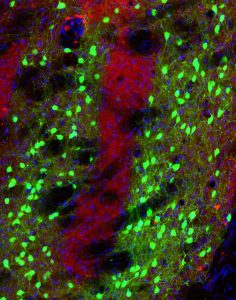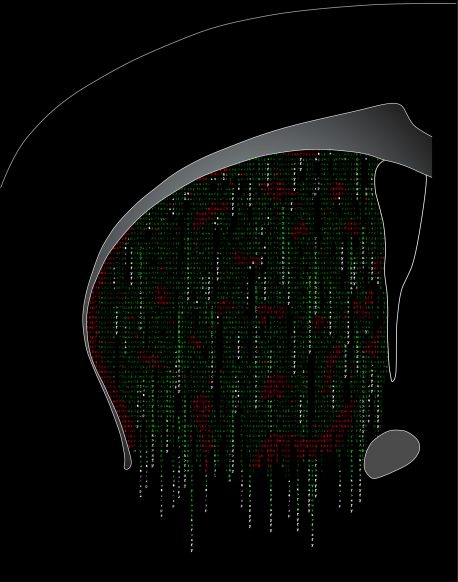
August 25, 2016
New work dispels long-held notions about area involved in Parkinson’s and addiction
New work dispels long-held notions about area involved in Parkinson’s and addiction

Click here for a high-resolution image
Credit: Salk Institute
LA JOLLA—When you reach for that pan of brownies, a ball-shaped brain structure called the striatum is critical for controlling your movement toward the reward. A healthy striatum also helps you stop yourself when you’ve had enough.
But when the striatum doesn’t function properly, it can lead to disorders such as Parkinson’s disease, obsessive-compulsive disorder or addiction.
In fact, the exact functions of the striatum are by no means resolved, and it’s also a mystery how the structure can coordinate many diverse functions. Now, a new study published August 25, 2016 by Salk Institute researchers and their colleagues in the journal Neuron, delves into the anatomy and function of the striatum by employing cutting-edge strategies to comprehensively map one of the brain’s lesser-known forms of organization.
“The most exciting result from this research is that we now have a new avenue to study long-standing questions about how the striatum controls movement in both healthy and diseased brains,” says the study’s senior investigator Xin Jin, an assistant professor in the Molecular Neurobiology Laboratory at Salk.
Forty years ago, researchers discovered a unique way that the striatum is organized. It is dotted with patch neurons, which under the microscope look like tiny islands of cells. The ocean surrounding them is made up of neurons scientists collectively refer to as “matrix” cells.
Over the course of four decades, scientists hypothesized about the role of patch and matrix neurons in neurodegenerative diseases. One idea was that patch cells were fed by the brain’s higher thought centers, suggesting they could play a role in cognition, whereas the matrix cells seemed to play a role in sensing and movement.

Click here for a high-resolution image
Credit: Salk Institute
In contrast, the new study dispels that idea, showing that both types of information are sent to the patch and matrix neurons, though patch cells tend to receive slightly more information from the brain’s emotion centers (these are included in the higher thought centers). But those results could help explain why, in the brains of patients with neurological disorders like Huntington’s disease (a progressive neurodegenerative disease affecting movement and other functions), patch cells and matrix cells are both affected, Jin says.
“This is an elegant example demonstrating that we are in a new era of studying brain circuits in ever more refined detail,” said Daofen Chen, Ph.D., program director at the NIH’s National Institute of Neurological Disorders and Stroke. “As a result of emerging technologies and novel tools, we are gaining new insights into mechanisms of brain disorders.”
Jin, together with the paper’s first authors Jared Smith, Jason Klug and Danica Ross, drew upon several technologies to uncover these new findings. The first was genetic engineering to selectively and precisely target the patch versus matrix neurons; traditionally, researchers used staining methods that were not as exact. Secondly, new neural tracing methods, including one generated by collaborator Edward Callaway and his group at Salk, allowed Jin’s team to chart the entire brain’s input to the patch and matrix cells and the output of each of the cell types as well. A third major approach, from the field of electrophysiology, enabled the scientists to confirm the connections they had mapped and to understand their strength.
“Much of the previous work on patch and matrix cells inferred their functions based on connectivity with the rest of the brain, but most of those hypotheses were incorrect,” Smith says. “With a more precise map of the input and output of patch and matrix cells, we can now make more informed hypotheses.”

Click here for a high-resolution image
Credit: Salk Institute
Patch and matrix neurons are not the only way that neuroscientists understand the striatum. The striatum also contains cells that take two opposing routes—the direct and indirect pathways—that are thought to provide the gas and brakes on movement, so to speak. Those indirect and direct pathways are also crucial for certain behaviors, such as the formation of new habits.
Interestingly, both patch and matrix groups contain both indirect and direct pathway cells. That makes the story of the striatum more complicated, Jin says, but in future studies his team can study the intersection of these two types of organization in the context of how the striatum controls actions in health and disease.
Other authors on the study are Jason Klug, Danica Ross, Christopher Howard, Nick Hollon, Vivian Ko, Hilary Hoffman and Edward Callaway of the Salk Institute; and Charles Gerfen of the National Institute of Mental Health in Bethesda, Maryland.
The research was supported by grants from the National Institutes of Health, the Dana Foundation, the Ellison Medical Foundation, and the Whitehall Foundation.
JOURNAL
Neuron
TITLE
Genetic-based dissection unveils the inputs and outputs of striatal patch and matrix compartments
AUTHORS
Jared B. Smith, Jason R. Klug, Danica L. Ross, Christopher D. Howard, Nick G. Hollon, Vivian I. Ko, Hilary Hoffman, Edward M. Callaway, Charles R. Gerfen, and Xin Jin
Office of Communications
Tel: (858) 453-4100
press@salk.edu
Unlocking the secrets of life itself is the driving force behind the Salk Institute. Our team of world-class, award-winning scientists pushes the boundaries of knowledge in areas such as neuroscience, cancer research, aging, immunobiology, plant biology, computational biology and more. Founded by Jonas Salk, developer of the first safe and effective polio vaccine, the Institute is an independent, nonprofit research organization and architectural landmark: small by choice, intimate by nature, and fearless in the face of any challenge.